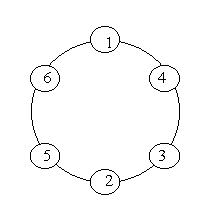HDOJ 1016 HDU 1016 Prime Ring Problem ACM 1016 IN HDU
Posted on 2010-08-18 12:32 MiYu 閱讀(723) 評(píng)論(0) 編輯 收藏 引用 所屬分類(lèi): ACM ( 枚舉 ) 、ACM ( 搜索 )題目地址:
http://acm.hdu.edu.cn/showproblem.php?pid=1016
題目描述:
Prime Ring Problem
Time Limit: 4000/2000 MS (Java/Others) Memory Limit: 65536/32768 K (Java/Others)Total Submission(s): 6150 Accepted Submission(s): 2745
Problem Description
A ring is compose of n circles as shown in diagram. Put natural number 1, 2, ..., n into each circle separately, and the sum of numbers in two adjacent circles should be a prime.
Note: the number of first circle should always be 1.

Note: the number of first circle should always be 1.

Input
n (0 < n < 20).
Output
The output format is shown as sample below. Each row represents a series of circle numbers in the ring beginning from 1 clockwisely and anticlockwisely. The order of numbers must satisfy the above requirements. Print solutions in lexicographical order.
You are to write a program that completes above process.
Print a blank line after each case.
You are to write a program that completes above process.
Print a blank line after each case.
Sample Input
6 8
Sample Output
Case 1: 1 4 3 2 5 6 1 6 5 2 3 4 Case 2: 1 2 3 8 5 6 7 4 1 2 5 8 3 4 7 6 1 4 7 6 5 8 3 2 1 6 7 4 3 8 5 2題目分析:典型的 DFS 題目, 不需要 什么剪枝, 直接 窮舉 + 回溯 就OK了, 不過(guò)值得一提的是,這題輸出很BT, 一般的 前后 輸出 回車(chē) , 第一個(gè)回車(chē)用 if( n == 1 ) 回車(chē); 來(lái)做PE了好幾次, 最后直接在程序最后 輸出2個(gè)回車(chē)符竟然就A了, YM啊...........代碼如下:/* MiYu原創(chuàng), 轉(zhuǎn)帖請(qǐng)注明 : 轉(zhuǎn)載自 ______________白白の屋 http://www.shnenglu.com/MiYu Author By : MiYu Test : Program : */ #include <iostream> using namespace std; bool prim[25]; int res[25]; bool hash[25]; int N; void setPrim () { memset ( prim, 0, sizeof ( prim ) ); prim[2] = prim[3] = prim[5] = prim[7] = prim[11] = prim[13] = prim[17] = prim[19] = prim[23] = true; } bool DFS ( int num , int n ) { res[n] = num; if ( n > N ) { return false; } if ( n == N - 1 ) { for ( int i = 2; i <= N; ++ i ) { if ( prim[num + i] && prim[ i + 1 ] && !hash[i] ) { res[n+1] = i; for ( int i = 1; i <= N; ++ i ) printf ( i == 1 ? "%d" : " %d",res[i] ); putchar ( '\n' ); } } } for ( int i = 2; i <= N; ++ i ) { if ( prim[ num + i ] && !hash[i] ) { hash[i] = true; DFS ( i, n + 1 ); hash[i] = false; } } return false; } int main () { setPrim (); int ca = 1; while ( cin >> N ) { sizeof ( hash, 0 , sizeof ( hash ) ); printf ( "Case %d:\n",ca++ ); hash[1] = true; DFS ( 1, 1 ); putchar ( '\n' ); } return 0; }



